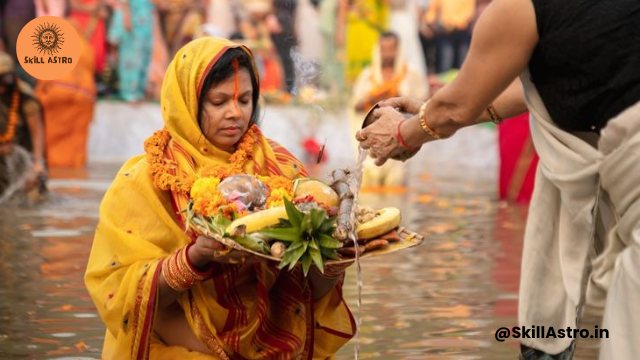
Chhath Puja is not just a fast; it is a divine blend of folk faith and inner purification. This festival symbolizes unwavering devotion toward the life-giving energy of the Sun and the benevolent blessings of Chhathi Maiya. It is celebrated with immense devotion and discipline across Bihar, Jharkhand, Eastern Uttar Pradesh, and the Terai regions of Nepal.
Chhath Puja 2025 Date and Auspicious Timings
In 2025, Chhath Puja will begin six days after Diwali, starting on Saturday, October 25. This sacred four-day ritual will follow the sequence below:
- Day 1 (October 25): Nahay-Khay
On this day, devotees bathe in holy rivers or ponds and prepare a pure vegetarian meal consisting of bottle gourd curry, chana dal, and steamed rice. This marks the first stage of physical and spiritual purification. - Day 2 (October 26): Lohanda and Kharna
Devotees observe a strict fast throughout the day, breaking it only after sunset with offerings of jaggery kheer, chapati, and bananas to the Sun God. After consuming the sacred prasad, they begin a rigorous 36-hour waterless fast. - Day 3 (October 27): Sandhya Arghya (Evening Offering)
Devotees gather at riverbanks with their families to offer arghya (water offerings) to the setting sun. The entire atmosphere becomes divine with the chanting of traditional Chhath songs and the glow of countless lamps. - Day 4 (October 28): Usha Arghya (Morning Offering)
The final day marks the conclusion of the fast as devotees offer arghya to the rising sun, praying for their family’s happiness, prosperity, and good health.
Spiritual and Scientific Significance of Chhath Puja
Chhath Puja holds deep yogic importance through meditation and breath control while exposed to sunlight. The rituals help detoxify the body, enhance concentration, and rejuvenate spiritual energy. According to folk beliefs, Chhathi Maiya protects progeny and blesses families with health, longevity, and prosperity.
Mythological Legends and Inspirations
- The Story of King Priyavrat and Queen Malini:
Childless for years, they were advised by Sage Kashyapa to perform a yajna. As a result, Goddess Shashthi (Chhathi Maiya) appeared and revived their deceased child. From that day, her worship began. - Ramayana Connection:
On Kartik Shukla Shashthi, Goddess Sita worshipped the Sun, which blessed her with two radiant sons, Lava and Kusha. - Mahabharata Connection:
Kunti invoked the Sun God and gave birth to Karna. Later, Draupadi too observed this fast to protect her family.
Vrat Rules: Do’s and Don’ts
Do’s:
- Clean the house thoroughly before starting the fast.
- Eat only sattvic food – avoid onion, garlic, and strong spices.
- Offer water standing in the river during sunrise and sunset.
- Prepare the prasad with utmost purity and devotion.
Don’ts:
- Do not touch the prasad with unclean hands.
- Avoid anger, quarrels, or impure thoughts during the festival.
- Do not consume salt after the Kharna ritual begins.
Social and Human Values of Chhath Puja
Chhath Puja teaches the importance of harmony between humans and nature. The unity, purity, and cooperative spirit seen at riverbanks reflect the soul of Indian culture. Every lamp, hymn, and offering symbolizes the divine connection between sunlight and human faith.
Frequently Asked Questions (FAQ)
1. When will Chhath Puja 2025 be celebrated?
It will be observed from October 25 to October 28, 2025, over four days.
2. Which is the main day of Chhath Puja?
October 27, 2025 – the evening offering (Sandhya Arghya) is considered the most significant day.
3. What are the main offerings (Prasad) during Chhath Puja?
The primary offerings include thekua, jaggery kheer, rice laddoos, coconuts, and seasonal fruits.
4. Is Chhath Puja celebrated only in Bihar?
No, the festival is now celebrated across India and around the world with equal devotion and reverence.
हिंदी में पढ़ें
